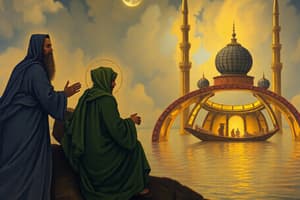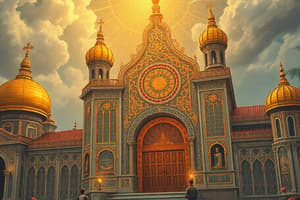Podcast
Questions and Answers
Which of the following best describes monotheism?
Which of the following best describes monotheism?
- Belief in a cyclic existence
- Belief in a single god (correct)
- Belief in multiple gods
- Belief in a pantheon of deities
Which historical event is associated with Christianity?
Which historical event is associated with Christianity?
- The Great Schism (correct)
- The Crusades of 1066
- The Aryan Migration
- The Hijrah
What are the Five Pillars of Islam primarily focused on?
What are the Five Pillars of Islam primarily focused on?
- Historical events and leaders
- Reincarnation and karma
- Core beliefs and practices (correct)
- Ethical living and meditation
Which of the following is a common sacred site for Judaism and Christianity?
Which of the following is a common sacred site for Judaism and Christianity?
What concept in Hinduism relates to the moral law of cause and effect?
What concept in Hinduism relates to the moral law of cause and effect?
Which of the following is not part of Buddhism?
Which of the following is not part of Buddhism?
Which religious leader is associated with Buddhism?
Which religious leader is associated with Buddhism?
Which of the following best describes the nature of the Crusades?
Which of the following best describes the nature of the Crusades?
What was a major contribution of Mansa Musa to the Mali empire?
What was a major contribution of Mansa Musa to the Mali empire?
Which climate zone is characterized by hot, dry conditions and scarce vegetation in Africa?
Which climate zone is characterized by hot, dry conditions and scarce vegetation in Africa?
How did the Bantu Migration influence the cultures of Africa?
How did the Bantu Migration influence the cultures of Africa?
What was the primary role of the griot in West African societies?
What was the primary role of the griot in West African societies?
Which of the following best describes the impact of the printing press in Renaissance society?
Which of the following best describes the impact of the printing press in Renaissance society?
What does the term 'Counter-Reformation' refer to?
What does the term 'Counter-Reformation' refer to?
Which concept is best associated with the Renaissance idea of a 'Renaissance man'?
Which concept is best associated with the Renaissance idea of a 'Renaissance man'?
What was the role of cowrie shells in the Kingdom of Benin?
What was the role of cowrie shells in the Kingdom of Benin?
What does the term 'Reformation' primarily refer to in a historical context?
What does the term 'Reformation' primarily refer to in a historical context?
Which of the following best defines the significance of October 31, 1517?
Which of the following best defines the significance of October 31, 1517?
What was Martin Luther's primary belief regarding indulgences?
What was Martin Luther's primary belief regarding indulgences?
Which of the following was a key technology that contributed to the Age of Exploration?
Which of the following was a key technology that contributed to the Age of Exploration?
What was one major outcome of the Columbian Exchange?
What was one major outcome of the Columbian Exchange?
The encomienda system primarily benefited which group in Spanish colonies?
The encomienda system primarily benefited which group in Spanish colonies?
What was a key effect of the Thirty Years' War in Europe?
What was a key effect of the Thirty Years' War in Europe?
Who was a prominent figure associated with the Enlightenment's ideas of separation of powers?
Who was a prominent figure associated with the Enlightenment's ideas of separation of powers?
Which term describes the forced journey of enslaved Africans to the Americas?
Which term describes the forced journey of enslaved Africans to the Americas?
Which of the following conditions were most commonly faced by enslaved Africans during the Middle Passage?
Which of the following conditions were most commonly faced by enslaved Africans during the Middle Passage?
Which ruler is known for his opposition to the absolutism in Europe during the Enlightenment?
Which ruler is known for his opposition to the absolutism in Europe during the Enlightenment?
What was a primary reason for John Wycliffe and Jan Hus's proposals for reform?
What was a primary reason for John Wycliffe and Jan Hus's proposals for reform?
Which of the following was a significant impact of the Ming Dynasty's changes toward European explorers?
Which of the following was a significant impact of the Ming Dynasty's changes toward European explorers?
Flashcards
Monotheistic
Monotheistic
The belief in one God. Christianity, Islam, and Judaism are all examples of monotheistic religions.
Polytheistic
Polytheistic
The belief in many gods. Ancient Greek and Roman religions were polytheistic.
Religion
Religion
A set of beliefs and practices that usually involves a supernatural being or beings, often with rituals, ceremonies, and moral codes. It's a way of understanding our place in the world and our relationship with the divine.
Reincarnation
Reincarnation
Signup and view all the flashcards
Karma
Karma
Signup and view all the flashcards
Yoga
Yoga
Signup and view all the flashcards
Four Noble Truths
Four Noble Truths
Signup and view all the flashcards
Eightfold Path
Eightfold Path
Signup and view all the flashcards
Heliocentric theory
Heliocentric theory
Signup and view all the flashcards
Scientific Revolution
Scientific Revolution
Signup and view all the flashcards
Scientific Revolution
Scientific Revolution
Signup and view all the flashcards
Renaissance
Renaissance
Signup and view all the flashcards
Ellipse
Ellipse
Signup and view all the flashcards
Sahel
Sahel
Signup and view all the flashcards
Matrilineal
Matrilineal
Signup and view all the flashcards
Griot
Griot
Signup and view all the flashcards
Hajj
Hajj
Signup and view all the flashcards
Madrasa
Madrasa
Signup and view all the flashcards
Subsistence Farming
Subsistence Farming
Signup and view all the flashcards
Swahili
Swahili
Signup and view all the flashcards
Study Notes
Unit 1 - World Religions
- Terms: Define religion, monotheistic, and polytheistic. Explain how these terms relate to the study of religions.
- Christianity: Key figures include Constantine, Charlemagne, and those involved in the Great Schism and Crusades. Key historical events and holy days/sites, and sacraments.
- Judaism: Main beliefs include kosher dietary laws and the name for God. Key historical events are the Diaspora. Key holy days/sites and sacraments are also important.
- Islam: Main beliefs include the Five Pillars. The inside of a mosque is decorated with specific elements for religious reasons. Key historical events include the Hijrah. Key figures include Sunni and Shia with information on the split between them as well as holy days and sites.
- Hinduism: Key concepts include karma, reincarnation, and the caste system. Historical events include the Aryan Migration. Key days/sites include the Ganges River and its significance to Hindus.
Unit 2 - African Civilizations
- Terms: Define Sahel, matrilineal, griot, hajj, madrasa, sharia, subsistence farming, and Swahili. Explain how these terms relate to the story of African civilizations.
- West Africa: Understand the importance of gold and salt in trade, the Niger River, trans-Saharan trade routes, and the role of Ghana, Mali, and Songhai. Key figures and their contributions, including Mansa Musa and significant kingdoms like Timbuktu.
- East Africa: Understand the role of Aksum and King Ezana/religion.
- General: Understand the climate zones of Africa and how they are linked to the cultures of the civilizations.
Unit 3 - Renaissance and Reformation
- Terms: Define Renaissance, humanism, patron, vernacular, "Renaissance man", Reconquista, Inquisition, Reformation, Protestant, 95 Theses, Martin Luther, indulgences, "priesthood of all believers", transubstantiation, 30 Years' War, Peace of Westphalia, and Counter-Reformation. Explain how these terms relate to the story.
- Main Ideas: Identify the major city of the Renaissance, contributions of key Renaissance figures (Medici Family, Filippo Brunelleschi, William Shakespeare, Michelangelo, Donatello, Leonardo da Vinci, Johannes Gutenberg, Miguel de Cervantes, Desiderius Erasmus, and Francisco Petrarcha), the impact of the printing press on world history and how figures such as Ferdinand and Isabella impacted Renaissance history.
- Reformation: Analyze the proposals of John Wycliffe and Jan Hus. Explain the Reformation and Christianity's change because of it. Identify the significance of October 31, 1517, and main beliefs of Martin Luther and the 95 Theses.
Unit 4 - Global Empires
- Terms: Define astrolabe, quadrant, sextant, compass, cartography, telescope, lateen sails, caravel, almanac, Columbian Exchange, Treaty of Tordesillas, "closed country" policy, indigenous, maize, slash & burn agriculture, chinampas, Templo Mayor, terraced farming, quipu, conquistadors, encomienda, social classes (peninsulares, creoles, mestizos, mulattos), joint stock company, Powhatan, cash crop, Pilgrims/Separatists, Mayflower Compact, Squanto/Tisquantum.
- Main Ideas: Explain the 3Gs. Identify how specific events, including Marco Polo's book, the Ottoman Turks conquering Constantinople, Ferdinand and Isabella, impacted exploration and important contributions of early explorers such as Marco Polo and Ibn Battuta.
Unit 5 - Scientific Revolution and Enlightenment
- Terms: Define Scientific Revolution, heliocentric theory, ellipse.
- Enlightenment: Define Enlightenment, philosophe, salon, absolute monarchy, natural rights, separation of powers, checks and balances, social contract theory, and capitalism. Main figures
- Main Ideas: Understand the connection between the Renaissance, Age of Exploration, and Scientific Revolution; identify contributions of scientists such as Nicolaus Copernicus, Johannes Kepler, Galileo, Isaac Newton, William Harvey, Robert Hooke, Margaret Cavendish, Rene Descartes, and Sir Francis Bacon; explain Galileo's struggles and how salons influenced the Enlightenment. Analyze the books and ideas of significant philosophes. Discuss the Enlightened despots and their reigns (Frederick the Great, Peter the Great, Catherine the Great, and Joseph II).
Studying That Suits You
Use AI to generate personalized quizzes and flashcards to suit your learning preferences.




